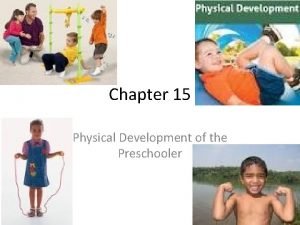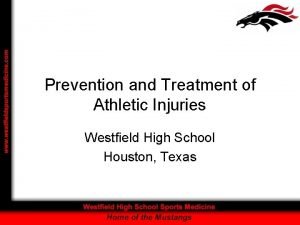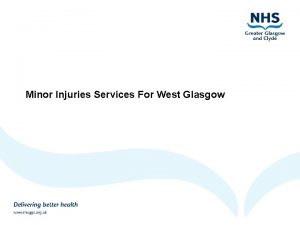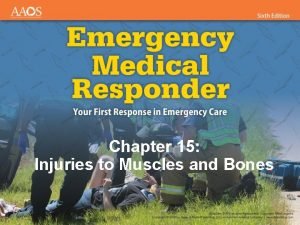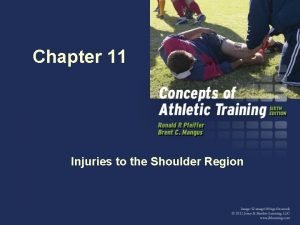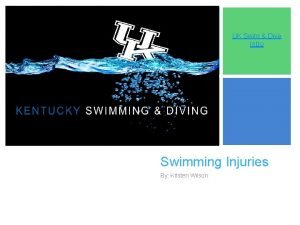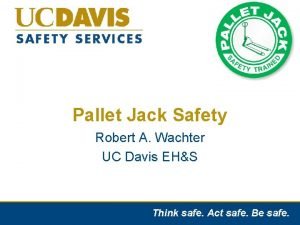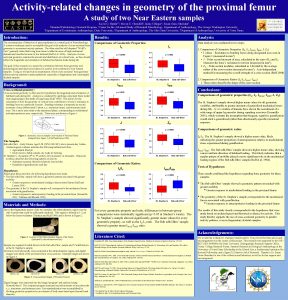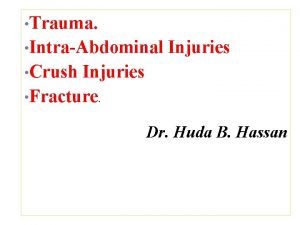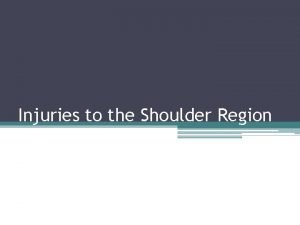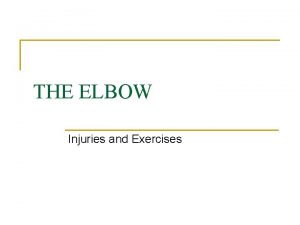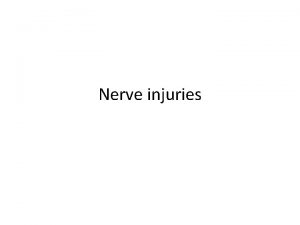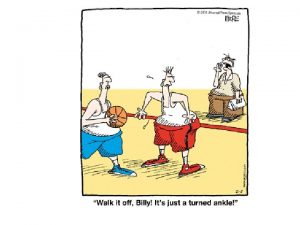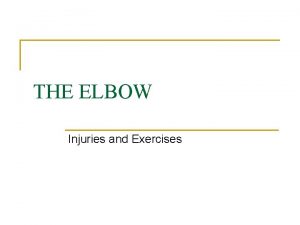Psychology of Physical ActivityRelated Injuries MODULE 13 PSYCHOLOGY




















- Slides: 20

Psychology of Physical Activity-Related Injuries MODULE 13 PSYCHOLOGY 310: SPORT & INJURY PSYCHOLOGY UNIVERSITY OF MARY INSTRUCTOR: DR. THERESA MAGELKY

Introduction �This chapter relates to participation in regular and recreational physical activity OUTSIDE of involvement in sports or competitive athletics �The physical and psychological benefits of regular physical activity are well documented �Although the benefits outweigh the risks, adopting an active lifestyle or increasing the volume or intensity of physical activity also increases the risk of injury �Musculoskeletal injury is most commonly reported adverse effect of physical activity – is frequently reported as the reason for ceasing involvement in physical activity or as a barrier to increasing activity

Introduction (cont. ) �Simply having a fear of injury has been reported as a major barrier to adopting a more active lifestyle �It is surprising, but minimal research has focused on response to injury in a recreational population Rather, research has mainly focused on injury within sports and competitive athletics

Physical Activity-Related Injuries: Prevalence �In studying injury prevalence in physically active and sedentary populations, the type and intensity of physical activity are important considerations Walking and moderate-intensity activity are associated with lower risk of injury compared with running/jogging and more vigorous intensity activities �Statistics indicate that injuries resulting from physical activity are just as prevalent as injuries resulting from sport

Physical Activity-Related Injuries: Prevalence (cont. ) �Risk factors for injury in a physically active population include: Participating in more than 1. 25 hours of activity per week Having a higher level of fitness Having had a previous injury Having a higher body mass index �Also, there is increased risk of injury and prolonged healing time with increasing age �As more individuals answer the call by national health organizations to participate in physical activity, and with a higher proportion of those individuals at risk for injury (e. g. , older in age, overweight), the prevalence of injuries will likely increase

Physical Activity-Related Injuries: Consequences �Many negative outcomes can be experienced as a result of physical activity-related injury Individual’s overall health can be affected through physical and psychological impairment There can be financial implications if injury influences the individual’s ability to work Some injuries can put a permanent stop to physical activity, even if the injury is only a temporary impairment Only 25% of those who experience an activity-related injury seek treatment Only 30 -40% of injured individuals comply with rehabilitation exercises � This leads to increased risk of future injury If individuals permanently cease physical activity following injury, they will no longer gain the widespread physiological and psychological health benefits of an active lifestyle

Physical Activity-Related Injuries: Consequences (cont. ) �Some individuals will return to activity following injury, and others will not �What are the psychological mechanisms that explain postinjury activity behavior? �Research of psychological responses to injury has drawn mainly from cognitive appraisal and stress process frameworks In physical activity context, whether an individual returns to their preinjury physical activity patterns and/or adheres to rehabilitation is influenced by his/her cognitive appraisal of, and affective reactions to, their injury These behavioral attempts then have their own set of consequences (e. g. , stress, experience of pain) that feed back into the cognitive and affective appraisal process

Integrated Model of Psychological Response to the Sport Injury and Rehabilitation Process (Wiese-Bjornstal at al. , 1998) The cognitive appraisals of the initial injury, followed by the emotional and behavioral responses that result, interact and are moderated by personal and situational factors including: �Goals �Identity �Self-efficacy �Causal attributions �Coping skills �Social Support �Pain Perceptions and fear of re-injury/re-injury anxiety

Integrated Model of Psychological Response to the Sport Injury and Rehabilitation Process �Goals – individuals trying to become regularly active typically have goal-directed behavior (e. g. , weight loss, enhanced appearance, improved health) the nature of, and reasons for, goal achievement influence psychological outcomes and thereby the cognitive appraisal of injury Perceptions of not making progress toward achieving goals produces distressing emotional states and disrupts selfregulation and behavior This intrinsic form of motivation is more prevalent in those who are in early stages of physical activity behavior change, and this appraisal will put them at risk of ceasing involvement in physical activity

Integrated Model of Psychological Response to the Sport Injury and Rehabilitation Process (cont. ) �Identity – an individual’s self-identity can be encapsulated within their role as an exerciser Injury results in an inability to fulfill this role, which results in challenge to this identity This can then lead to cognitive and affective reactions Research has found that when those with a strong exercise identity were unable to exercise, the result was a negative affective response � This negative affective response then acts as a motivator to return to activity in order to regain consistency between identity and behavior

Integrated Model of Psychological Response to the Sport Injury and Rehabilitation Process (cont. ) �Self-Efficacy – an individual’s belief in his or her abilities Self-efficacy is one of strongest determinants of participation in physical activity and influences affective and cognitive outcomes of physical activity Following an injury, individual’s appraisal of their self-efficacy will be prominent in the psychological response to injury and will influence future behavior, including adherence to rehab There a variety of self-efficacy beliefs that operate in physical activity domain: � Task self-efficacy- ability to complete certain activities � Barrier self-efficacy – ability to overcome environmental and personal barriers that exist to being active � Recovery self-efficacy – ability to resume a behavior after a lapse – this also influences future activity levels

Integrated Model of Psychological Response to the Sport Injury and Rehabilitation Process (cont. ) �Causal Attributions – an individual’s beliefs about the cause of an injury – these beliefs influence affective and behavioral responses Cause of injury can be: � Attributed to internal or external (personal/environmental factors) � Can be stable or unstable (unchangeable/changeable) � Can be perceived as personally controllable or not Determining the cause/context of activity-related injury suggests that if the individual takes personal responsibility for the injury & perceives that the causal factors do not change over time but are personally controllable, an adaptive psychological and behavioral response will result

Integrated Model of Psychological Response to the Sport Injury and Rehabilitation Process (cont. ) �Coping Skills – the extent to which the individual feels they have appropriate coping resources and skills is proposed to influence their cognitive appraisals Also, the extent to which the individual implements strategies to manage the stress presented by the injury is suggested as a behavioral outcome of the stress appraisal process Coping skills are usually defined according to two main processes: � Problem-focused coping – refers to cognitive and behavioral attempts to manage or change the problem that is causing stress � Emotion-focused coping – refers to attempts to regulate the emotional response to the problem � Research suggests that problem-focused coping strategies are more advantageous than emotion-focused coping

Integrated Model of Psychological Response to the Sport Injury and Rehabilitation Process (cont. ) �Social Support – this is a key situational factor that can influence the psychological response to physical activity-related injury in several ways: It can reduce perceptions of stress posed by the injury It can improve affective responses It can build self-efficacy �The nature and provider of social support is important Sport medicine professionals usually provide informational support Family and friends usually provide emotional and practical support

Integrated Model of Psychological Response to the Sport Injury and Rehabilitation Process (cont. ) �Pain Perceptions and Fear of Re-Injury/Re-Injury Anxiety – Individuals who engage in catastrophizing focus excessively on pain sensations (rumination), exaggerate threat of pain sensations (magnification), and doubt their ability to cope with situations that induce pain (helplessness) Extent to which individuals engage in catastrophizing may influence intensity of pain experienced as a result of injury, influence adherence to injury rehabilitation exercises, and may influence confidence in being able to return to physical activity The experience of pain from the initial injury contributes to fears and/or anxieties about re-injury because the individual is worried they will suffer further pain

Suggested Psychological Interventions for Rehabilitation and Resuming Physical Activity Goal-Setting: �Suspend previous activity-related goals while injured to reduce the sense of non-accomplishment of goals and create new achievable goals for the rehab period �Replace old physical activity routines with a new rehabilitation routine �On return to activity, new activity goals should acknowledge the individual’s lowered level of functioning post-injury to limit the risk of re-injury and build self-efficacy �Recognize the enjoyment and value gained from being active and not just the extrinsic rewards

Suggested Psychological Interventions for Rehabilitation and Resuming Physical Activity Imagery �Imagine successfully performing rehabilitation exercises �Imagine being active without pain �Imagine being active at pre-injury capabilities

Suggested Psychological Interventions for Rehabilitation and Resuming Physical Activity Positive self-talk: �Reframe negative thoughts �Celebrate successes; give positive feedback Personal Control: �Identify how to overcome new barriers to activity presented by injury �Take responsibility for the occurrence of injury and rehabilitation

Suggested Psychological Interventions for Rehabilitation and Resuming Physical Activity Social Support �Seek out appropriate social support from general practitioners, physical therapists, family, and friends to provide emotional and practical support �Connect with activity friends in other ways (for example, attend the after-activity social event) Self-identity �Maintain pre-injury habits where possible �Recognize other aspects of life that bring meaning and enjoyment �Maintain identity as an exerciser. The break is only temporary.

References �Arvinen-Barrow, M. , & Walker, N. (2013). The Psychology of Sport Injury and Rehabilitation (1 st ed. ). Routledege.
 C device module module 1
C device module module 1 Module 15 preschoolers physical development
Module 15 preschoolers physical development Module 46 infancy and childhood physical development
Module 46 infancy and childhood physical development Tim madsen climber
Tim madsen climber Unit 15:3 providing first aid for bleeding and wounds
Unit 15:3 providing first aid for bleeding and wounds How is katniss in peeta’s debt again?
How is katniss in peeta’s debt again? What are sentinel injuries
What are sentinel injuries Westfield sports injuries
Westfield sports injuries Yorkhill minor injuries
Yorkhill minor injuries Human crutch method
Human crutch method Chapter 28 head and spine injuries
Chapter 28 head and spine injuries Chapter 21 caring for head and spine injuries
Chapter 21 caring for head and spine injuries 17:10 providing first aid for specific injuries
17:10 providing first aid for specific injuries Emr chapter 15 injuries to muscles and bones
Emr chapter 15 injuries to muscles and bones Chapter 14:3 observing fire safety
Chapter 14:3 observing fire safety Chapter 14 bleeding shock and soft tissue injuries
Chapter 14 bleeding shock and soft tissue injuries Chapter 13:2 preventing accidents and injuries
Chapter 13:2 preventing accidents and injuries Chapter 11 injuries to the shoulder region
Chapter 11 injuries to the shoulder region Chapter 11 assessment and evaluation of sports injuries
Chapter 11 assessment and evaluation of sports injuries Tnt swimming
Tnt swimming Pallet jack injuries
Pallet jack injuries

